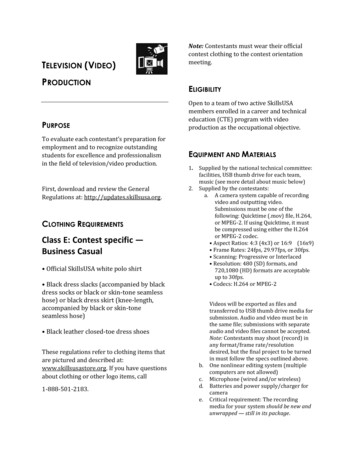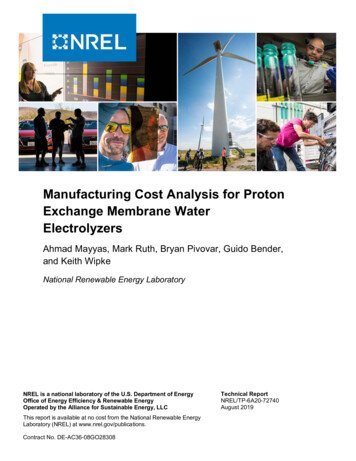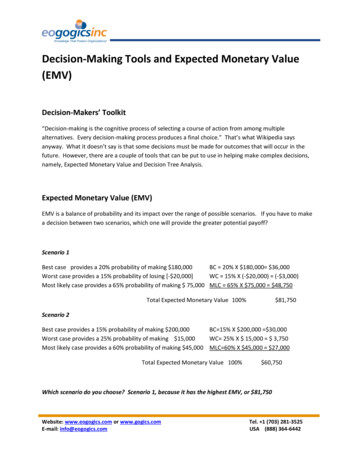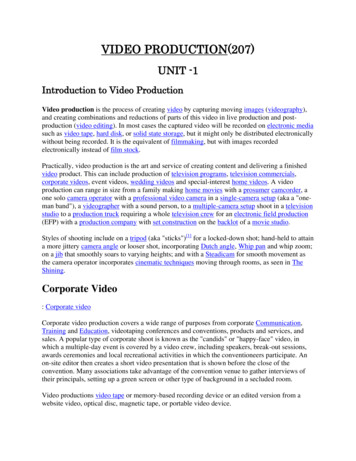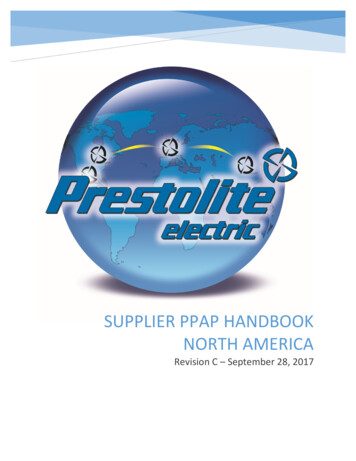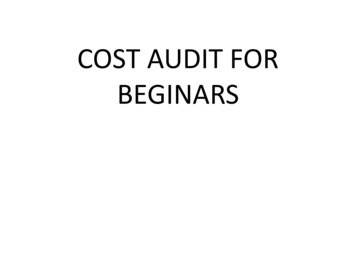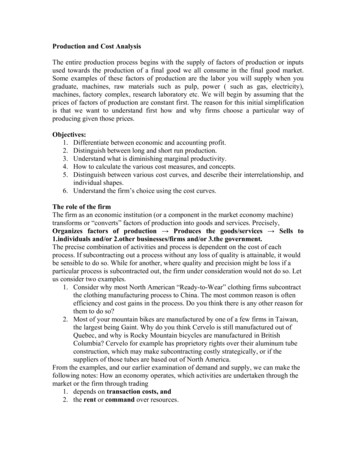
Transcription
Production and Cost AnalysisThe entire production process begins with the supply of factors of production or inputsused towards the production of a final good we all consume in the final good market.Some examples of these factors of production are the labor you will supply when yougraduate, machines, raw materials such as pulp, power ( such as gas, electricity),machines, factory complex, research laboratory etc. We will begin by assuming that theprices of factors of production are constant first. The reason for this initial simplificationis that we want to understand first how and why firms choose a particular way ofproducing given those prices.Objectives:1. Differentiate between economic and accounting profit.2. Distinguish between long and short run production.3. Understand what is diminishing marginal productivity.4. How to calculate the various cost measures, and concepts.5. Distinguish between various cost curves, and describe their interrelationship, andindividual shapes.6. Understand the firm’s choice using the cost curves.The role of the firmThe firm as an economic institution (or a component in the market economy machine)transforms or “converts” factors of production into goods and services. Precisely,Organizes factors of production Produces the goods/services Sells to1.individuals and/or 2.other businesses/firms and/or 3.the government.The precise combination of activities and process is dependent on the cost of eachprocess. If subcontracting out a process without any loss of quality is attainable, it wouldbe sensible to do so. While for another, where quality and precision might be loss if aparticular process is subcontracted out, the firm under consideration would not do so. Letus consider two examples.1. Consider why most North American “Ready-to-Wear” clothing firms subcontractthe clothing manufacturing process to China. The most common reason is oftenefficiency and cost gains in the process. Do you think there is any other reason forthem to do so?2. Most of your mountain bikes are manufactured by one of a few firms in Taiwan,the largest being Gaint. Why do you think Cervelo is still manufactured out ofQuebec, and why is Rocky Mountain bicycles are manufactured in BritishColumbia? Cervelo for example has proprietory rights over their aluminum tubeconstruction, which may make subcontracting costly strategically, or if thesuppliers of those tubes are based out of North America.From the examples, and our earlier examination of demand and supply, we can make thefollowing notes: How an economy operates, which activities are undertaken through themarket or the firm through trading1. depends on transaction costs, and2. the rent or command over resources.
Consider another simple real life example: From it’s inception, Timbuk2 bags weremanufactured out of San Francisco, and the marketing pitch was that it was homegrown,and home built. Visit their website, and see how many of their line of bags aremanufactured within San Francisco, and which are subcontracted out to Chinesemanufacturing.How do we model a Firm’s choice?1. Firms Maximize ProfitsWhen you choose to purchase a particular good, you intrinsically choose theobject that gives you the greatest enjoyment or joy. We translate the same conceptinto firms’ choice, but unlike your enjoyment, which is difficult to measure, theconceptualization of the firms’ choice is a little easier. We simply monetize thegains in terms of profits, after netting off wages, and rents. It is a simple idea, thegreater the total revenue, the greater the share that can be paid out, and the morethat can be reinvested to further develop the product line, and increase marketshare. Of course not every firm can be described by this idea, for example a nonprofit hospital. However, what we will be describing will describe the majority ofthe firms we see. In terms of an equation, a firm maximizes then the following,Profit Total Revenue – Total CostConceptually, total revenue equals total sales multiply by price. While total costis the sum of wage rate, rental rates etc multiply by the number of units and timeput into used. However, we must note the following finer points,1. However in accounting, accountants focus on explicit revenues and costs, orquantifiable revenues and cost that enter into the “books”. In terms of revenue,there is no difference. However, the difference arises when we think of costs.Accountants focus on quantifiable cost, i.e. amounts they receive printed on theirreceipts.2. An economist on the other hand include implicit costs, that is,Total Cost Implicit Cost Explicit CostImplicit Cost includes the opportunity cost of the factors of production.2. The Production ProcessRecall that when we consider supply curve that the long run supply is moreelastic than the short run supply curve. The rationale we had was that in the shortrun, certain factors of production or inputs into a process are not variable. Hencethe supply is inelastic, or quantities supplied is unresponsive to changes in ownprice changes. Note again, when we say short and long run, it does notnecessarily mean a particular duration or number of years. It just differentiatesbetween when some factors of production are not variable (Short Run), and whenit is all variable (Long Run).
a. Production Tables and Production FunctionsProduction tables and functions are an easy for us to conceptualize howfirms choose their optimal combinations of inputs. Our description heredoes not describe the whole process, but a simplification. You have to bemindful of this. This is done in detail in subjects such as OperationsResearch.The first two columns of the following table tells you somethingimportant. It tells you how much input, in this case, the number ofworkers, need to be hired to produce a certain amount of product. In otherwords, it tells you the relationship between the inputs (factor ofproduction) and output. Of course a real firm needs more factors ofproduction that just labor.What other information can be gleamed from the table. First note that atany time, a firm has some variables to meet immediate changes indemand, but others it can not. Examples of the former are labor andmaterials, while examples of the latter are factory floor space, number ofmachines used in a manufacturing process. There is a very interestingnotion that can be introduced here, and that is the concept of marginalproduct, which means the additional output that will result from anadditional input (say labor), holding the level of other inputs constant.Note that this concept is different from average product, which meansthe output per worker. A variation of figure 9-1 on page 203 of your textshows you how marginal and average product is calculated and graphed.What can you say about the changes in the marginal and average productof labor?TotalCalculationNumber ng the numbers on a diagram may help you see the relationship.
Total OutputDecreasing MarginalProductivity60Increasing MarginalProductivity40Increasing MarginalProductivity202.5Number of Workers7.5Output/WorkerAverage Product ofLaborMarginal Product ofLaborNumber of WorkersThe main idea is the following:1.That marginal product initially rises, but diminishes eventually.The term of this is diminishing marginal productivity. This is oftenreferred to as the The Law of Diminishing Marginal Productivity, andstates that as more and more of a variable input is added to an existingfixed input in production, eventually the additional output produced by anadditional unit of the variable input will fall. Note that this idea relates toour conception of our short and long run supply and production.
2.The average product rises at a slower rate, and intersects themarginal product curve as the latter is falling.b. The cost of ProductionHere are some cost concepts which we will use, and whoseinterrelationship we will examine. Be patient, their significance will beapparent shortly.Fixed Cost (FC): Cost that are spent and cannot be changed in the periodof time under consideration.Variable Cost (VC): Costs that change as output changes.Total Cost Fixed Cost (FC) Variable Cost (VC)Average Total Cost or Average Cost (ATC): Is just the cost ofproducing a unit of a product. Let Q be the quantity supplied orproduced. As its name suggest, it is calculated asATC TC/Q (FC VC) / Q.Average Fixed Cost (AFC): Is just the fixed cost involved in producing aunit of a product.AFC FC / Q.Note the following, even without drawing a graph, or using a table, theconcept of FC would inform you that AFC falls the more of a product isproduced.Average Variable Cost (AVC): Is just the variable cost involved inproducing a unit of a product.AVC VC / Q.The following relationship follows:TC FC VCWhich implies thatTC / Q (FC VC) / QWhich givesATC AFC AVCOne final cost concept is the following: Marginal Cost (MC), which isthe cost involved in the production of an additional unit of a product.In other words,MC Change in Total Cost / Change in Quantity Produced TC / Q
Idiosyncrasies of the relationship between the various cost curve.1. The difference between the TC and VC is precisely the fixed cost. That is there isno difference in the slope of the TC and VC, and the sole difference is in theintercept of the TC which is just the FC.CostTCVCFCFCQ2. The ATC and AVC is a U shaped curve. Why? We know that as quantity suppliedincreases, every additional unit of those quantities require the same or more inputor factors of production due to the Law of Diminishing Marginal Productivity.Put another way, although as long as the firm manufactures at or within it’scapacity, cost would fall as more is produced, since it is “within it’s capacity”.But when those capacities are reached, an additional unit of input produces lessthan the last input. That is it starts becoming more expensive to produce theadditional unit, since it requires more of the variable inputs. The firm would needmore variable input to manufacture that additional unit, and if each unit of inputmust be paid the same rate, the cost would increase faster than the rate of increasein quantity supplied. That point at which this capacity constraint is incurrediswhere ATC and AVC starts rising.3. The point where the ATC and AVC starts rising is also when MC intersects it.Why is this so? When the marginal cost (MC) of an additional unit of product isstill below the ATC or the AVC, it means that the firm can still increaseproduction by an additional unit and have it shared among all its quantitiesproduced without raising the per unit total and average cost. However, oncemarginal cost is sufficiently high, the firm would not be able to raise inproduction without impunity. That is it will not be able to increase productionwithout increasing per unit cost it faces, and hence the intersection. The reason forthe intersection of AVC to be sooner and ATC is because of the fixed costelement in total cost. But can we prove this without a shadow of doubt. Well we
can, and the following shows it. Let C(.) be the cost dependent on the quantitiessupplied, Q. Note: This will not be tested.C (Q )ATC QC (Q ) 0 C ' (Q ) 0 MC ATC ATC QC ' (Q ) C (Q ) Q C (Q ) QQ2 0 C ' (Q ) 0 MC ATC QThe prove for variable cost is similar.4. Why is the AFC downward sloping? The reason is simple. Fixed Cost is aconstant, or a unvarying number, while its divisor, quantity is increasing. So asthe quantity supplied rises, the divisor increases, but the numerator stays thesame, and AFC is strictly decreasing, and is asymptotically 0. And by virtue ofthis ATC and AVC tends towards each other as quantity supplied increases sinceATC AFC AVC.Unit CostMCATCAVCAFCQ
The Explicit Relationship between Marginal Productivity and Marginal CostCost per UnitMCAVCOutputOutput per FactorAPMPUnits of FactorThe relationship depicted above parallels our description of why the MC and AVC, andATC are U shaped, and the juncture where they intersect. To reiterate our point;1. MC starts rising only when MP starts falling.2. The point where MP equates with AP (point where AP and MP intersects) is thepoint where AVC and MC intersect. The point where AP intersect MP is the pointwhere the additional unit of output by the factor under consideration can nolonger be shared among all the other units of the factor under consideration (saylabor) so that the per unit production of the factor input starts falling (AP). Sinceall units of the factor input are paid the same rate, it would also describe the pointwhere AVC starts rising. Note that this diagram does not describe the relationshipbetween productivity and the ATC, since ATC includes the AFC which pertainsto the non-variable fixed factors.
Production and Cost Analysis The entire production process begins with the supply of factors of production or inputs used towards the production of a final good we all consume in the final good market.




